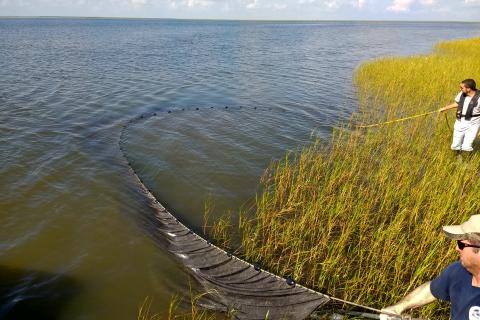The Louisiana trustees recently released the Gear Comparison Study for Sampling Nekton in Barataria Basin Marshes report (PDF, 67 pages). Funded by the Trustee Implementation Group, it summarizes a field study that compared nekton catch with different types of gear in Barataria Basin. Nekton are aquatic animals that swim, such as fish, shrimp, and crabs. Sampling these organisms helps us understand how restoration work is helping them, and their habitat, recover.
The report compares nekton sampling gear to understand which are better in different scenarios and monitoring needs. We will use this information in making decisions regarding coastal restoration activities with the goal of reducing costs and optimizing our efforts.
Over the 2018 and 2019 study period, nekton were collected using gear types including seine nets; electrofishers, which temporarily stun fish through the use of electricity; and throw traps in habitat along marsh edges in waters with varying salinity levels. The catch for each gear type was compared in terms of catch per unit effort (CPUE), species richness, size, distribution, and nekton assemblages.
The key findings include:
- CPUE was highest for electrofisher and lowest for throw traps.
- CPUE was similar for electrofisher and seine when grass shrimp, the most abundant type of nekton species collected, were removed from calculations.
- Density of nekton was highest for throw traps and lowest for seine.
- Number of species and number of unique species were highest for electrofisher.
These results show that there are trade-offs in selecting gear types for estuarine nekton monitoring of density, abundance, species richness, and assemblages. Other important considerations include cost, the labor required to conduct sampling, logistics, and potential uncertainties related to how effective each gear type is for sampling the wide variety of conditions found across Louisiana’s coastal habitats. The study will inform selection of monitoring protocols for Deepwater Horizon restoration projects.
The report is available through the Louisiana Coastal Protection and Restoration Authority’s Coastal Information Management System. Co-authors were from Louisiana Department of Wildlife and Fisheries, The Water Institute of the Gulf, Dynamic Solutions, LLC, Louisiana State University Agricultural Center, and the U.S. Geological Survey.


